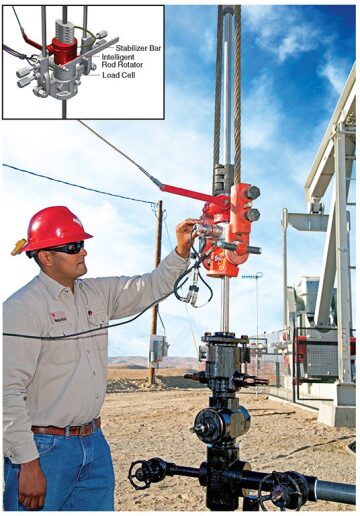Reciprocating rod lift has been a mainstay artificial lift method for onshore oil producing wells for nearly a century, helping to keep marginal wells producing for as long as economically possible. However, the constant up-and-down movement of a sucker rod creates the risk of erosion wear on the rod and the production tubing. If left unchecked, the well may require a costly intervention for repairs.
Sucker rod rotators have been used for decades to extend the working life of sucker rods. Conventional rod rotators, which have been used since the 1950s, are ratchet-type mechanical devices that incrementally rotate the rod with each stroke. The rotation evenly distributes the wear around the circumference of the rod and couplings, rather than isolating the wear to one side.
Until recently, there has not been an accurate method to monitor rod rotator function. An inefficient or inoperable rod rotator does little or nothing to extend rod life and puts the integrity of the rod-pumping system at risk. Short of traveling to the wellsite and visually verifying rotator operation, there has been no sure way of knowing if the rotator has slowed down or stopped working.
An Intelligent Alternative
To counter this inherently inefficient process, Weatherford has developed an intelligent rod rotator (Fig. 1) that significantly reduces the time needed to identify a failed rotator and thereby extends the life of the rod while reducing the risk of an unplanned well shutdown. Designed to integrate seamlessly into any existing rod-pump controller system, the device incorporates several new technologies that take the guesswork out of rotator failures.

The first technology innovation is an internal rotation sensor, which is a fundamental component of the intelligent rod rotator itself. The sensor detects each rotation of the rod and sends a signal to a rod-pump controller. The sensor interfaces with the controller through a software application that detects each rotation of the rod based on the signal coming from the sensor into the controller.
The software application, which is built into a web-based, well management and production optimization platform, collects the rotation data once a day. In addition, the software provides real-time monitoring and alarm communication. If the signal from the rotator is interrupted, indicating that rotation has stopped, an alarm will be generated at the wellsite and transmitted to the field office. The operator is prompted to investigate the cause of the alarm, which may require sending a team to the well to make repairs.
The intelligent rod rotator’s signal can be detected by any real-time software package monitoring the well. Thus, operators can use their existing monitoring software to track rod rotator data.
This flexibility in field deployment prompted the second sensing technology upgrade—a modification kit that can be installed on wells with any type and configuration of rod rotator already in place. The upgrade kit consists of a rotation sensor, sensing magnet and strap, mounting kit, load cell, and ancillary cables. It enables operators to take advantage of the monitoring power of the company’s system without having to discard the rod rotators they already have.
The third technology advancement is in the transmission of signals. A special cable and connector enables the load sensor signal and rod rotator data to be transmitted to the rod-pump controller on the same cable. Both parameters can be measured without deploying additional cables in the field, which reduces operating expenses and safety risk.
Meeting Operator Objectives
The intelligent rod rotator was developed in response to a specific need from an operator in California who had approximately 6,000 rod-pumped wells in a 10-sq-mile area. Roughly half of the wells included a conventional rod rotator. However, the operator did not have a reliable or efficient means of knowing whether they were working. A problem would only be discovered during a wellsite visit by field personnel, typically every 3 to 4 weeks. The lack of a monitoring system made it impossible to determine if the rotator had stopped functioning 3 weeks earlier or minutes before the crew had arrived.
Originally, the operator planned to hire personnel to drive around the field continually to inspect each rotator. It would have required 2 days to identify problem rotators and schedule them for maintenance. It then would have taken days to weeks for a repair crew to arrive, with further risk of rod failure during the interim. The operator believed this inspection-to-repair regimen to be inefficient and risky.
The first field trials of the intelligent rod rotator were conducted for the operator in summer 2012. The operator had two objectives:
- Reduce the time needed to identify a failed rod rotator.
- Increase remote surveillance capability.
Both objectives were achieved. The new tool was able to count the number of strokes per day and detect when a failure had occurred. The system consistently and accurately notified the operator, providing on-site and remote notification, within 24 hours of a failure.
The intelligent rod rotator enabled the operator to begin managing its wells by exception and to schedule maintenance on the basis of the needed priorities. Higher-producing wells were the first to receive rod rotator maintenance, resulting in an increased effectiveness of the operator’s maintenance program and reduced operational expense.
Upgrades in Progress
Following the initial trial successes, the system is being upgraded. Prototypes of other intelligent rod rotator systems of new sizes are being built to correspond to the load requirements and depths of different wells. A wireless system for transmitting the signal from the rod rotator to the rod-pump controller is being developed. A software application that can reduce the failure notification time from a daily to an hourly basis is under development. As the upgrades progress, new field trials in the United States are planned during the year.
In addition, an intelligent tubing rotator is being developed, which is based on the general design of the rod rotator system, but is placed below the wellhead to monitor tubing rotation underground.

